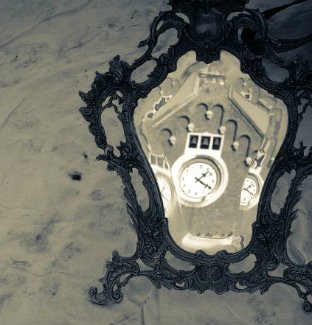The same night for years

There are three nights a year when I feel like I am standing in a tunnel cut through space-time. This tunnel is well lit but narrow, cutting vertically through the years like a probe boring through layers of sedimentary rock. It opens briefly, each of these three nights, after a worship service has ended. It is dark out on Maundy Thursday, Good Friday, or Christmas Eve. There are a few people still in the building chatting or cleaning up, and I am finally taking off my robes, alone in the vesting room.
I see myself in the closet mirror and I feel like I’m in a mirror reflecting a mirror, repeated over and over. Another year has passed, but this moment is exactly the same. Something has happened—Jesus is born, or betrayed, or killed. We have said the prayers, listened to the words, sung the songs, and performed the actions. Then people go home, and I go back to the vesting room to change—where I feel as though I’m walking into a time warp. I’m standing in the same vestments I wore last year, and seven years before. It seems like a single night, instead of eight distinct nights over eight years.
I’m not sure why Christmas pageants, Easter, and Pentecost don’t strike me in the same way. Sunday mornings at church are busy and bubbly with energy and expectation, so it may be that the stillness of nighttime worship is more conducive to reflection and quiet wonder.
We tend to focus on the linear nature of time: children grow up and adults grow old, savings increase and expenses rise, careers advance and goals are met, some things succeed and others fail. As Christians, we look back toward Creation and forward toward the end of time, waiting for Christ’s return. Most things—from Creation to the Incarnation to our first wedding anniversary—we believe are unique events that happen only once.
We pay less attention perhaps to the ways time is circular, even from a Christian perspective. From the time we are born, we enter certain patterns of life lived by those before us. We share the physical experience of birth with all human beings, and we share in infant baptism or dedication with Christians through the centuries. We attend worship on Sundays, just as generations of Christians before us have, using many of the same words, hymns, and gestures. If we marry, we join untold numbers of couples that have married before us, in many cases using the very same vows. We grieve for our dead with the same anguish, loss, and confusion as generations have before us. These things stretch back through time—and around the world, through both the present and the past.
We often focus on what makes a birth, or wedding, or death, or funeral service unique to us or a loved one. But we are also part of an immeasurable community of saints—of human beings, Christian or not—who have done and felt the same things we are doing and feeling, through time and into eternity, like a mirror reflecting a mirror.
Circular time may make us feel that time is short: another Christmas has past, another birthday gone by. But even birthdays can remind us that time is also abundant. Birthdays come every year. There is the cycle of seasons—the same flowering bulbs, summer heat, and changing leaves. There is the agony of changing our clocks twice a year. The holidays we love return year after year; so do the ones we dread. And we probably celebrate holidays in much the same way each year, so they may collapse together into a familiar tableau of fireworks, or Christmas trees, or Halloween decorations, so that it’s hard to tell one year apart from another.
The cycle of time—whether it’s another Holy Week or another wedding or another funeral—is also a way to feel part of something bigger than ourselves: the promise of God in Christ that this life is not all there is, the vast communion of saints through space and time who share this humanity with us. That communion also will carry itself and us, with God’s grace, into a future we can’t see—except perhaps in the mirror-in-a-mirror of certain human moments, like tunnels cut in the sediment of space-time, revealing both the breadth and the intimacy of eternity.





